Analysis and Comparison: Wind Augmentation Device for Power Generation
VerifiedAdded on 2019/09/20
|22
|5834
|193
Project
AI Summary
This assignment analyzes and compares a custom-constructed small-scale wind augmentation device with a wind-guide attachment to improve wind power generation. The study begins with an introduction to wind energy, its history, and the two main types of wind turbines: horizontal and vertical axis. It explores the benefits of wind power, including reduced greenhouse gas emissions and decreased reliance on fossil fuels, while also discussing the adoption of wind energy and its environmental and economic advantages. The core of the assignment focuses on wind power augmentation, examining methods to increase turbine efficiency, such as diffuser-augmented wind turbines and cone-shaped wind guide systems. The study aims to develop and test a wind augmentation device to enhance the efficiency of small-scale experimental wind turbines, comparing its performance numerically and experimentally with turbines without the device, to increase airflow and overall efficiency. The purpose is to design and test a wind augmentation device to improve the efficiency of small-scale experimental wind turbines.
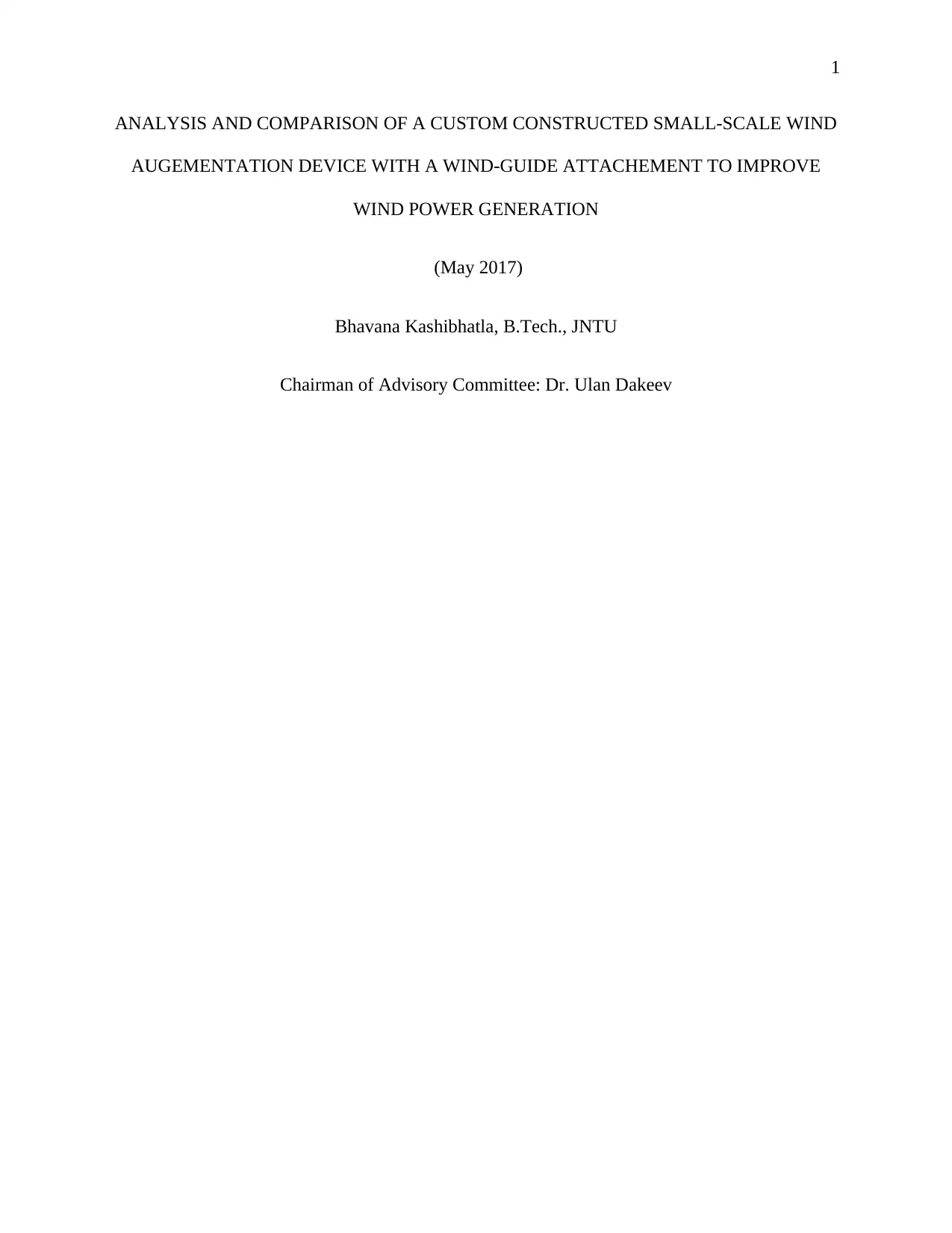
1
ANALYSIS AND COMPARISON OF A CUSTOM CONSTRUCTED SMALL-SCALE WIND
AUGEMENTATION DEVICE WITH A WIND-GUIDE ATTACHEMENT TO IMPROVE
WIND POWER GENERATION
(May 2017)
Bhavana Kashibhatla, B.Tech., JNTU
Chairman of Advisory Committee: Dr. Ulan Dakeev
ANALYSIS AND COMPARISON OF A CUSTOM CONSTRUCTED SMALL-SCALE WIND
AUGEMENTATION DEVICE WITH A WIND-GUIDE ATTACHEMENT TO IMPROVE
WIND POWER GENERATION
(May 2017)
Bhavana Kashibhatla, B.Tech., JNTU
Chairman of Advisory Committee: Dr. Ulan Dakeev
Paraphrase This Document
Need a fresh take? Get an instant paraphrase of this document with our AI Paraphraser

2
CHAPTER - 1
INTRODUCTION
Wind energy is one of the most reliable and abundant sources of renewable energy on this
planet. The humankind has used it for centuries as there are estimates that people were using this
type of energy as far as 4,000 years ago. In the year 1700, it was employed by the king of
Babylon for irrigation purposes (Ackermann & Kuwahata, 2013). The wind was also for
grinding grain by several farmers. It is also surprising to note that one of the earliest windmills
had the vertical axis of rotation. The people use braided mats or sails for rotating these windmills
across the vertical axis. These windmills had an operational advantage as they were independent
of the direction of the wind.
History of Wind Power
The wind power was initially utilized by humans in the form of irrigation pumping, sailboats
and garn milling. The history of wind power can easily be tracked back to the ancient 6,000
years ago. The sails, ships and sailboats were used on the Nile River though its water, in Egypt.
The earliest known use of wind power was represented by the sailboats. Although as per today’s
standard, it is considered to be a rudimentary use of wind but the technology impacted the
development of the current sail-type windmills (Hansen, M. O., 2015). The first documented
proof of the existence of such mills dates back to 12th century. However, the ability to study the
wind power across the horizontal axis was the first to measure in the 20th century (Kuwahata
et.al, 2013).
There are two types of wind turbines. One is built with high speed and is intended to generate
electricity whereas the other one is built for low wind speeds (Wahab et al. 2008). The major
CHAPTER - 1
INTRODUCTION
Wind energy is one of the most reliable and abundant sources of renewable energy on this
planet. The humankind has used it for centuries as there are estimates that people were using this
type of energy as far as 4,000 years ago. In the year 1700, it was employed by the king of
Babylon for irrigation purposes (Ackermann & Kuwahata, 2013). The wind was also for
grinding grain by several farmers. It is also surprising to note that one of the earliest windmills
had the vertical axis of rotation. The people use braided mats or sails for rotating these windmills
across the vertical axis. These windmills had an operational advantage as they were independent
of the direction of the wind.
History of Wind Power
The wind power was initially utilized by humans in the form of irrigation pumping, sailboats
and garn milling. The history of wind power can easily be tracked back to the ancient 6,000
years ago. The sails, ships and sailboats were used on the Nile River though its water, in Egypt.
The earliest known use of wind power was represented by the sailboats. Although as per today’s
standard, it is considered to be a rudimentary use of wind but the technology impacted the
development of the current sail-type windmills (Hansen, M. O., 2015). The first documented
proof of the existence of such mills dates back to 12th century. However, the ability to study the
wind power across the horizontal axis was the first to measure in the 20th century (Kuwahata
et.al, 2013).
There are two types of wind turbines. One is built with high speed and is intended to generate
electricity whereas the other one is built for low wind speeds (Wahab et al. 2008). The major
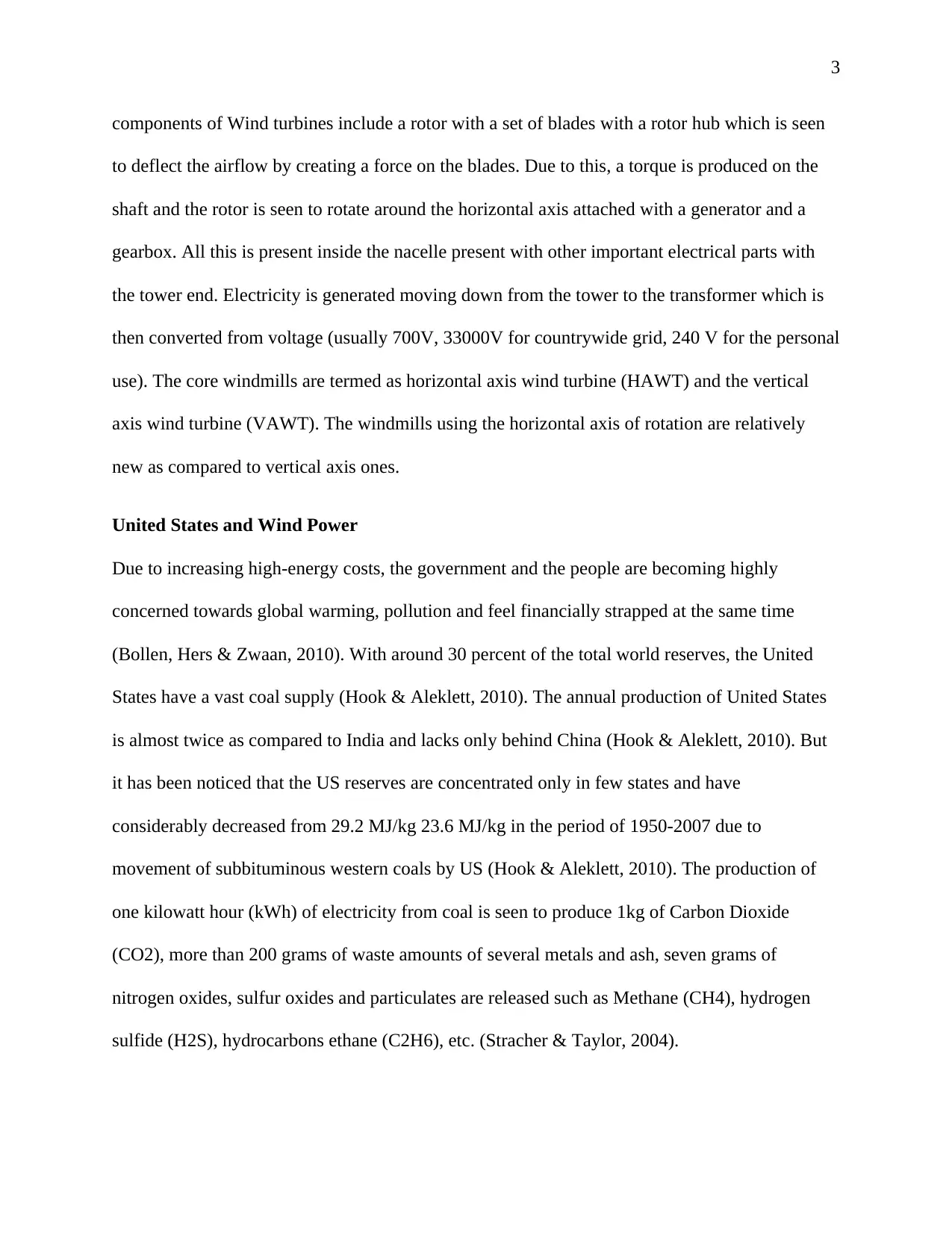
3
components of Wind turbines include a rotor with a set of blades with a rotor hub which is seen
to deflect the airflow by creating a force on the blades. Due to this, a torque is produced on the
shaft and the rotor is seen to rotate around the horizontal axis attached with a generator and a
gearbox. All this is present inside the nacelle present with other important electrical parts with
the tower end. Electricity is generated moving down from the tower to the transformer which is
then converted from voltage (usually 700V, 33000V for countrywide grid, 240 V for the personal
use). The core windmills are termed as horizontal axis wind turbine (HAWT) and the vertical
axis wind turbine (VAWT). The windmills using the horizontal axis of rotation are relatively
new as compared to vertical axis ones.
United States and Wind Power
Due to increasing high-energy costs, the government and the people are becoming highly
concerned towards global warming, pollution and feel financially strapped at the same time
(Bollen, Hers & Zwaan, 2010). With around 30 percent of the total world reserves, the United
States have a vast coal supply (Hook & Aleklett, 2010). The annual production of United States
is almost twice as compared to India and lacks only behind China (Hook & Aleklett, 2010). But
it has been noticed that the US reserves are concentrated only in few states and have
considerably decreased from 29.2 MJ/kg 23.6 MJ/kg in the period of 1950-2007 due to
movement of subbituminous western coals by US (Hook & Aleklett, 2010). The production of
one kilowatt hour (kWh) of electricity from coal is seen to produce 1kg of Carbon Dioxide
(CO2), more than 200 grams of waste amounts of several metals and ash, seven grams of
nitrogen oxides, sulfur oxides and particulates are released such as Methane (CH4), hydrogen
sulfide (H2S), hydrocarbons ethane (C2H6), etc. (Stracher & Taylor, 2004).
components of Wind turbines include a rotor with a set of blades with a rotor hub which is seen
to deflect the airflow by creating a force on the blades. Due to this, a torque is produced on the
shaft and the rotor is seen to rotate around the horizontal axis attached with a generator and a
gearbox. All this is present inside the nacelle present with other important electrical parts with
the tower end. Electricity is generated moving down from the tower to the transformer which is
then converted from voltage (usually 700V, 33000V for countrywide grid, 240 V for the personal
use). The core windmills are termed as horizontal axis wind turbine (HAWT) and the vertical
axis wind turbine (VAWT). The windmills using the horizontal axis of rotation are relatively
new as compared to vertical axis ones.
United States and Wind Power
Due to increasing high-energy costs, the government and the people are becoming highly
concerned towards global warming, pollution and feel financially strapped at the same time
(Bollen, Hers & Zwaan, 2010). With around 30 percent of the total world reserves, the United
States have a vast coal supply (Hook & Aleklett, 2010). The annual production of United States
is almost twice as compared to India and lacks only behind China (Hook & Aleklett, 2010). But
it has been noticed that the US reserves are concentrated only in few states and have
considerably decreased from 29.2 MJ/kg 23.6 MJ/kg in the period of 1950-2007 due to
movement of subbituminous western coals by US (Hook & Aleklett, 2010). The production of
one kilowatt hour (kWh) of electricity from coal is seen to produce 1kg of Carbon Dioxide
(CO2), more than 200 grams of waste amounts of several metals and ash, seven grams of
nitrogen oxides, sulfur oxides and particulates are released such as Methane (CH4), hydrogen
sulfide (H2S), hydrocarbons ethane (C2H6), etc. (Stracher & Taylor, 2004).
⊘ This is a preview!⊘
Do you want full access?
Subscribe today to unlock all pages.

Trusted by 1+ million students worldwide
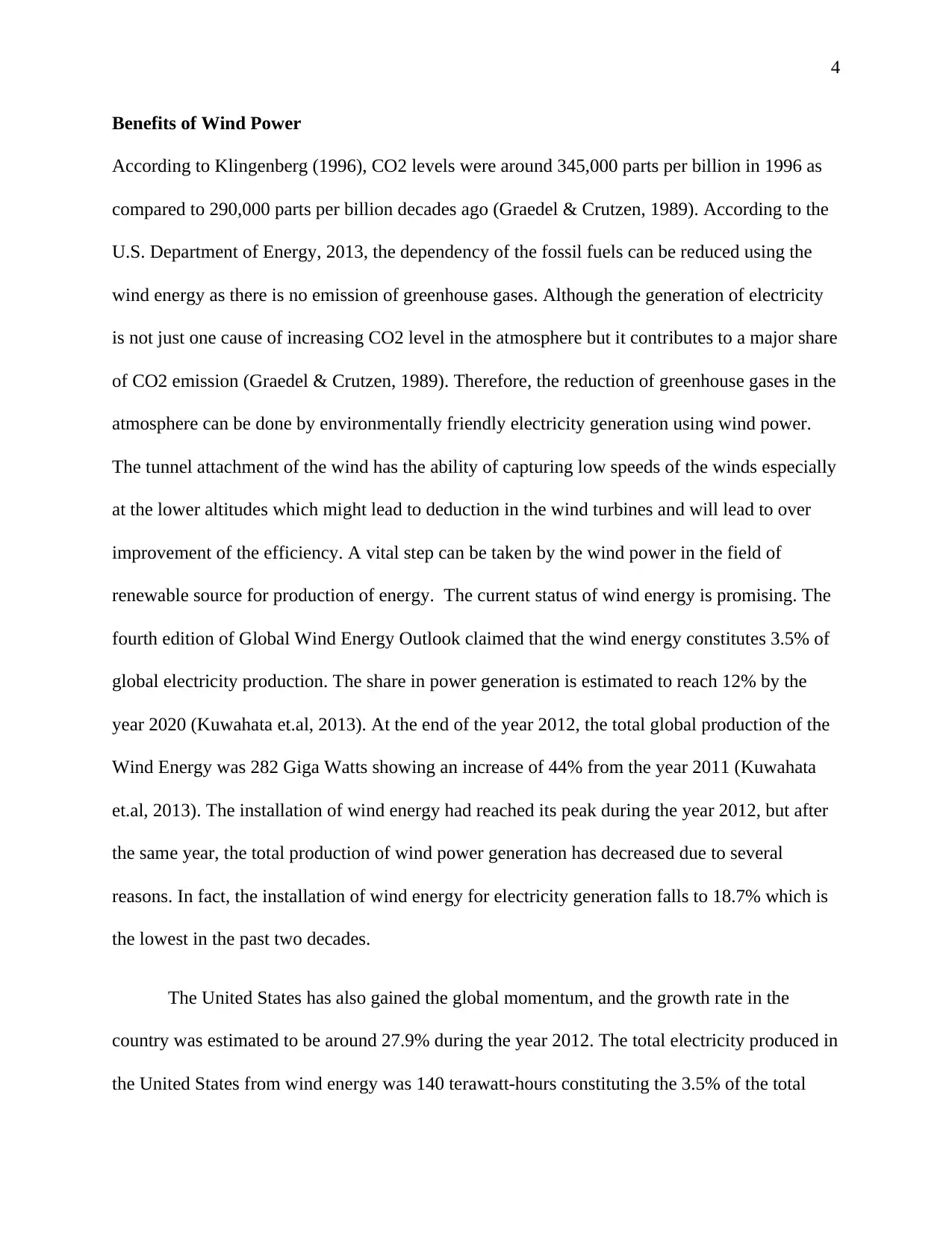
4
Benefits of Wind Power
According to Klingenberg (1996), CO2 levels were around 345,000 parts per billion in 1996 as
compared to 290,000 parts per billion decades ago (Graedel & Crutzen, 1989). According to the
U.S. Department of Energy, 2013, the dependency of the fossil fuels can be reduced using the
wind energy as there is no emission of greenhouse gases. Although the generation of electricity
is not just one cause of increasing CO2 level in the atmosphere but it contributes to a major share
of CO2 emission (Graedel & Crutzen, 1989). Therefore, the reduction of greenhouse gases in the
atmosphere can be done by environmentally friendly electricity generation using wind power.
The tunnel attachment of the wind has the ability of capturing low speeds of the winds especially
at the lower altitudes which might lead to deduction in the wind turbines and will lead to over
improvement of the efficiency. A vital step can be taken by the wind power in the field of
renewable source for production of energy. The current status of wind energy is promising. The
fourth edition of Global Wind Energy Outlook claimed that the wind energy constitutes 3.5% of
global electricity production. The share in power generation is estimated to reach 12% by the
year 2020 (Kuwahata et.al, 2013). At the end of the year 2012, the total global production of the
Wind Energy was 282 Giga Watts showing an increase of 44% from the year 2011 (Kuwahata
et.al, 2013). The installation of wind energy had reached its peak during the year 2012, but after
the same year, the total production of wind power generation has decreased due to several
reasons. In fact, the installation of wind energy for electricity generation falls to 18.7% which is
the lowest in the past two decades.
The United States has also gained the global momentum, and the growth rate in the
country was estimated to be around 27.9% during the year 2012. The total electricity produced in
the United States from wind energy was 140 terawatt-hours constituting the 3.5% of the total
Benefits of Wind Power
According to Klingenberg (1996), CO2 levels were around 345,000 parts per billion in 1996 as
compared to 290,000 parts per billion decades ago (Graedel & Crutzen, 1989). According to the
U.S. Department of Energy, 2013, the dependency of the fossil fuels can be reduced using the
wind energy as there is no emission of greenhouse gases. Although the generation of electricity
is not just one cause of increasing CO2 level in the atmosphere but it contributes to a major share
of CO2 emission (Graedel & Crutzen, 1989). Therefore, the reduction of greenhouse gases in the
atmosphere can be done by environmentally friendly electricity generation using wind power.
The tunnel attachment of the wind has the ability of capturing low speeds of the winds especially
at the lower altitudes which might lead to deduction in the wind turbines and will lead to over
improvement of the efficiency. A vital step can be taken by the wind power in the field of
renewable source for production of energy. The current status of wind energy is promising. The
fourth edition of Global Wind Energy Outlook claimed that the wind energy constitutes 3.5% of
global electricity production. The share in power generation is estimated to reach 12% by the
year 2020 (Kuwahata et.al, 2013). At the end of the year 2012, the total global production of the
Wind Energy was 282 Giga Watts showing an increase of 44% from the year 2011 (Kuwahata
et.al, 2013). The installation of wind energy had reached its peak during the year 2012, but after
the same year, the total production of wind power generation has decreased due to several
reasons. In fact, the installation of wind energy for electricity generation falls to 18.7% which is
the lowest in the past two decades.
The United States has also gained the global momentum, and the growth rate in the
country was estimated to be around 27.9% during the year 2012. The total electricity produced in
the United States from wind energy was 140 terawatt-hours constituting the 3.5% of the total
Paraphrase This Document
Need a fresh take? Get an instant paraphrase of this document with our AI Paraphraser
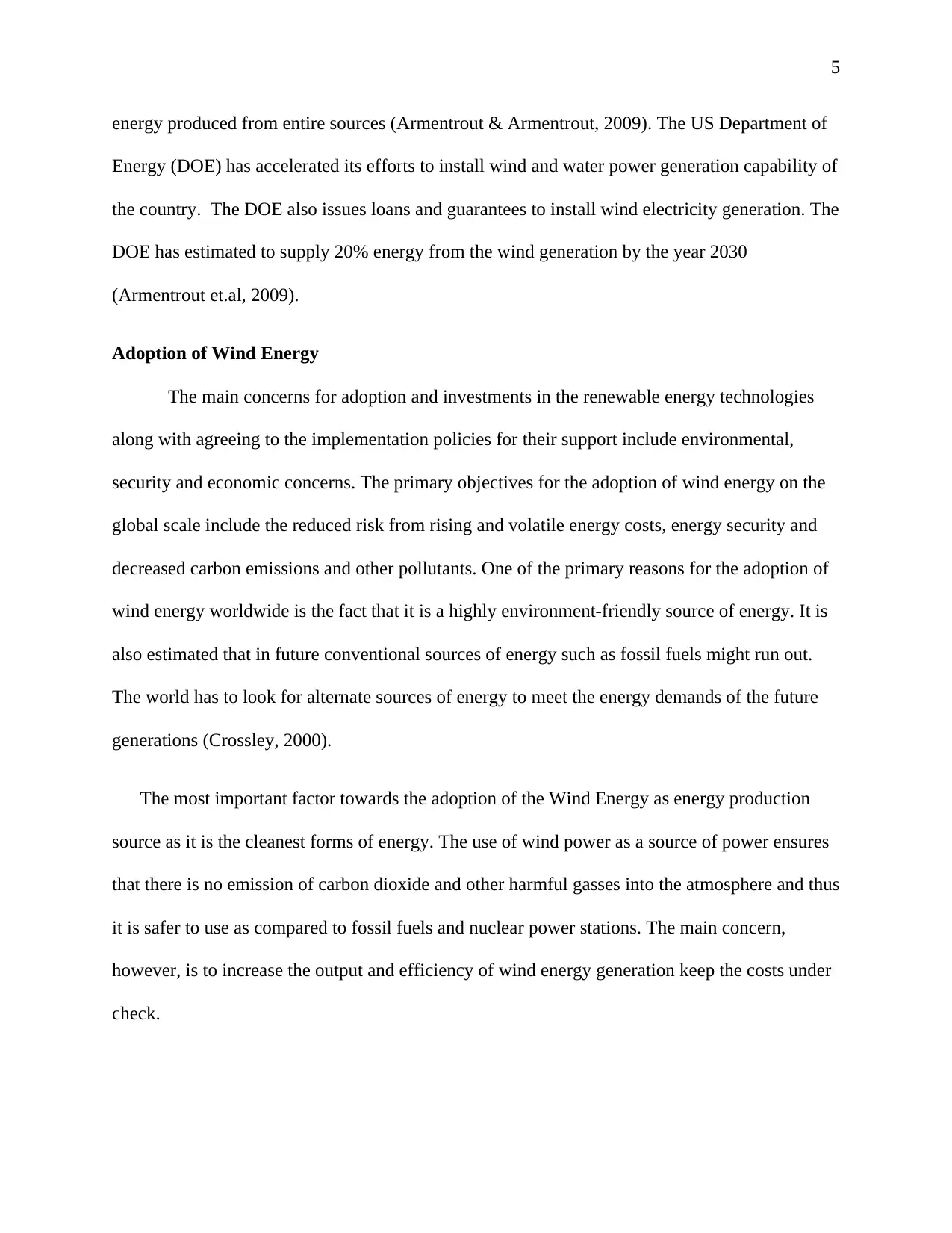
5
energy produced from entire sources (Armentrout & Armentrout, 2009). The US Department of
Energy (DOE) has accelerated its efforts to install wind and water power generation capability of
the country. The DOE also issues loans and guarantees to install wind electricity generation. The
DOE has estimated to supply 20% energy from the wind generation by the year 2030
(Armentrout et.al, 2009).
Adoption of Wind Energy
The main concerns for adoption and investments in the renewable energy technologies
along with agreeing to the implementation policies for their support include environmental,
security and economic concerns. The primary objectives for the adoption of wind energy on the
global scale include the reduced risk from rising and volatile energy costs, energy security and
decreased carbon emissions and other pollutants. One of the primary reasons for the adoption of
wind energy worldwide is the fact that it is a highly environment-friendly source of energy. It is
also estimated that in future conventional sources of energy such as fossil fuels might run out.
The world has to look for alternate sources of energy to meet the energy demands of the future
generations (Crossley, 2000).
The most important factor towards the adoption of the Wind Energy as energy production
source as it is the cleanest forms of energy. The use of wind power as a source of power ensures
that there is no emission of carbon dioxide and other harmful gasses into the atmosphere and thus
it is safer to use as compared to fossil fuels and nuclear power stations. The main concern,
however, is to increase the output and efficiency of wind energy generation keep the costs under
check.
energy produced from entire sources (Armentrout & Armentrout, 2009). The US Department of
Energy (DOE) has accelerated its efforts to install wind and water power generation capability of
the country. The DOE also issues loans and guarantees to install wind electricity generation. The
DOE has estimated to supply 20% energy from the wind generation by the year 2030
(Armentrout et.al, 2009).
Adoption of Wind Energy
The main concerns for adoption and investments in the renewable energy technologies
along with agreeing to the implementation policies for their support include environmental,
security and economic concerns. The primary objectives for the adoption of wind energy on the
global scale include the reduced risk from rising and volatile energy costs, energy security and
decreased carbon emissions and other pollutants. One of the primary reasons for the adoption of
wind energy worldwide is the fact that it is a highly environment-friendly source of energy. It is
also estimated that in future conventional sources of energy such as fossil fuels might run out.
The world has to look for alternate sources of energy to meet the energy demands of the future
generations (Crossley, 2000).
The most important factor towards the adoption of the Wind Energy as energy production
source as it is the cleanest forms of energy. The use of wind power as a source of power ensures
that there is no emission of carbon dioxide and other harmful gasses into the atmosphere and thus
it is safer to use as compared to fossil fuels and nuclear power stations. The main concern,
however, is to increase the output and efficiency of wind energy generation keep the costs under
check.
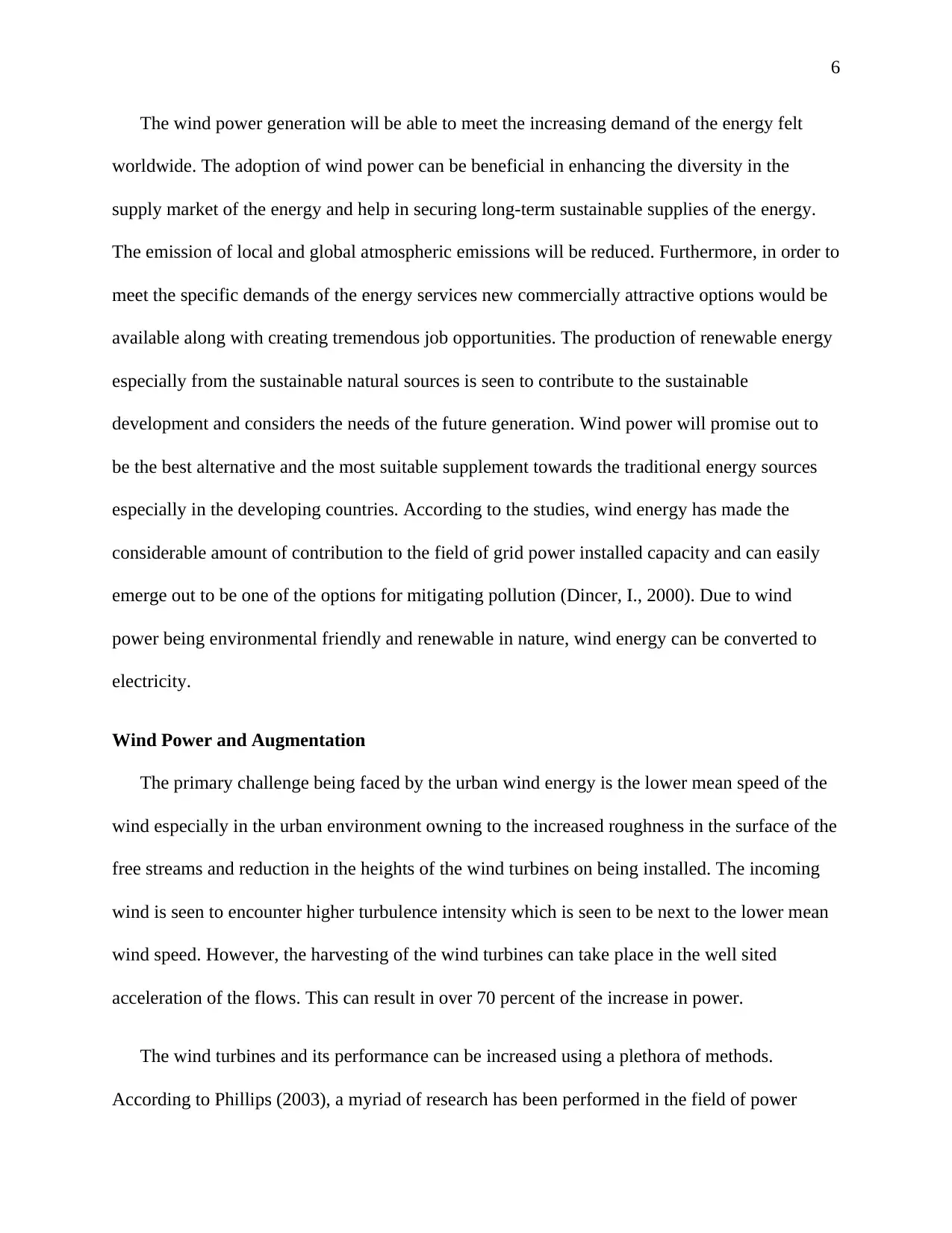
6
The wind power generation will be able to meet the increasing demand of the energy felt
worldwide. The adoption of wind power can be beneficial in enhancing the diversity in the
supply market of the energy and help in securing long-term sustainable supplies of the energy.
The emission of local and global atmospheric emissions will be reduced. Furthermore, in order to
meet the specific demands of the energy services new commercially attractive options would be
available along with creating tremendous job opportunities. The production of renewable energy
especially from the sustainable natural sources is seen to contribute to the sustainable
development and considers the needs of the future generation. Wind power will promise out to
be the best alternative and the most suitable supplement towards the traditional energy sources
especially in the developing countries. According to the studies, wind energy has made the
considerable amount of contribution to the field of grid power installed capacity and can easily
emerge out to be one of the options for mitigating pollution (Dincer, I., 2000). Due to wind
power being environmental friendly and renewable in nature, wind energy can be converted to
electricity.
Wind Power and Augmentation
The primary challenge being faced by the urban wind energy is the lower mean speed of the
wind especially in the urban environment owning to the increased roughness in the surface of the
free streams and reduction in the heights of the wind turbines on being installed. The incoming
wind is seen to encounter higher turbulence intensity which is seen to be next to the lower mean
wind speed. However, the harvesting of the wind turbines can take place in the well sited
acceleration of the flows. This can result in over 70 percent of the increase in power.
The wind turbines and its performance can be increased using a plethora of methods.
According to Phillips (2003), a myriad of research has been performed in the field of power
The wind power generation will be able to meet the increasing demand of the energy felt
worldwide. The adoption of wind power can be beneficial in enhancing the diversity in the
supply market of the energy and help in securing long-term sustainable supplies of the energy.
The emission of local and global atmospheric emissions will be reduced. Furthermore, in order to
meet the specific demands of the energy services new commercially attractive options would be
available along with creating tremendous job opportunities. The production of renewable energy
especially from the sustainable natural sources is seen to contribute to the sustainable
development and considers the needs of the future generation. Wind power will promise out to
be the best alternative and the most suitable supplement towards the traditional energy sources
especially in the developing countries. According to the studies, wind energy has made the
considerable amount of contribution to the field of grid power installed capacity and can easily
emerge out to be one of the options for mitigating pollution (Dincer, I., 2000). Due to wind
power being environmental friendly and renewable in nature, wind energy can be converted to
electricity.
Wind Power and Augmentation
The primary challenge being faced by the urban wind energy is the lower mean speed of the
wind especially in the urban environment owning to the increased roughness in the surface of the
free streams and reduction in the heights of the wind turbines on being installed. The incoming
wind is seen to encounter higher turbulence intensity which is seen to be next to the lower mean
wind speed. However, the harvesting of the wind turbines can take place in the well sited
acceleration of the flows. This can result in over 70 percent of the increase in power.
The wind turbines and its performance can be increased using a plethora of methods.
According to Phillips (2003), a myriad of research has been performed in the field of power
⊘ This is a preview!⊘
Do you want full access?
Subscribe today to unlock all pages.

Trusted by 1+ million students worldwide
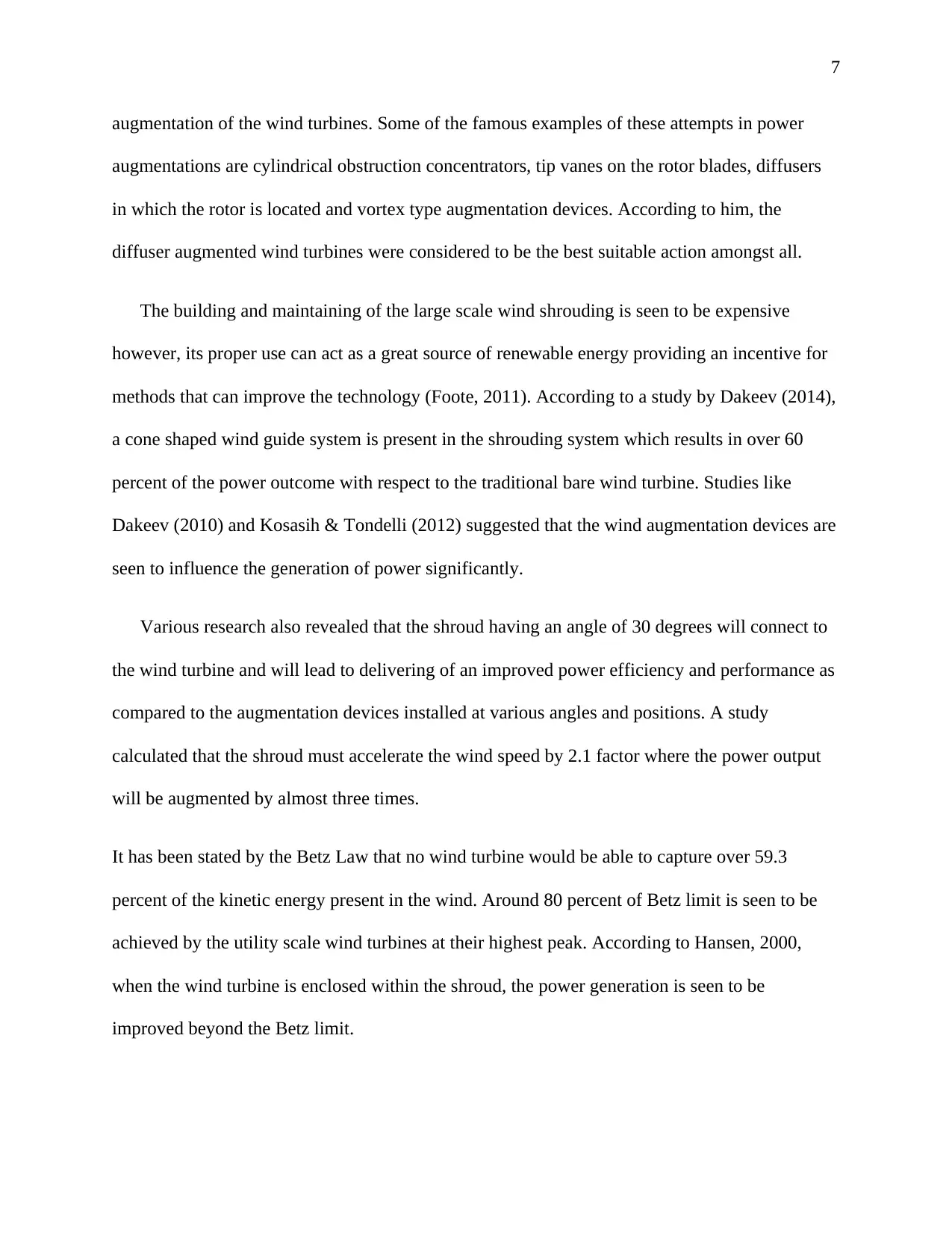
7
augmentation of the wind turbines. Some of the famous examples of these attempts in power
augmentations are cylindrical obstruction concentrators, tip vanes on the rotor blades, diffusers
in which the rotor is located and vortex type augmentation devices. According to him, the
diffuser augmented wind turbines were considered to be the best suitable action amongst all.
The building and maintaining of the large scale wind shrouding is seen to be expensive
however, its proper use can act as a great source of renewable energy providing an incentive for
methods that can improve the technology (Foote, 2011). According to a study by Dakeev (2014),
a cone shaped wind guide system is present in the shrouding system which results in over 60
percent of the power outcome with respect to the traditional bare wind turbine. Studies like
Dakeev (2010) and Kosasih & Tondelli (2012) suggested that the wind augmentation devices are
seen to influence the generation of power significantly.
Various research also revealed that the shroud having an angle of 30 degrees will connect to
the wind turbine and will lead to delivering of an improved power efficiency and performance as
compared to the augmentation devices installed at various angles and positions. A study
calculated that the shroud must accelerate the wind speed by 2.1 factor where the power output
will be augmented by almost three times.
It has been stated by the Betz Law that no wind turbine would be able to capture over 59.3
percent of the kinetic energy present in the wind. Around 80 percent of Betz limit is seen to be
achieved by the utility scale wind turbines at their highest peak. According to Hansen, 2000,
when the wind turbine is enclosed within the shroud, the power generation is seen to be
improved beyond the Betz limit.
augmentation of the wind turbines. Some of the famous examples of these attempts in power
augmentations are cylindrical obstruction concentrators, tip vanes on the rotor blades, diffusers
in which the rotor is located and vortex type augmentation devices. According to him, the
diffuser augmented wind turbines were considered to be the best suitable action amongst all.
The building and maintaining of the large scale wind shrouding is seen to be expensive
however, its proper use can act as a great source of renewable energy providing an incentive for
methods that can improve the technology (Foote, 2011). According to a study by Dakeev (2014),
a cone shaped wind guide system is present in the shrouding system which results in over 60
percent of the power outcome with respect to the traditional bare wind turbine. Studies like
Dakeev (2010) and Kosasih & Tondelli (2012) suggested that the wind augmentation devices are
seen to influence the generation of power significantly.
Various research also revealed that the shroud having an angle of 30 degrees will connect to
the wind turbine and will lead to delivering of an improved power efficiency and performance as
compared to the augmentation devices installed at various angles and positions. A study
calculated that the shroud must accelerate the wind speed by 2.1 factor where the power output
will be augmented by almost three times.
It has been stated by the Betz Law that no wind turbine would be able to capture over 59.3
percent of the kinetic energy present in the wind. Around 80 percent of Betz limit is seen to be
achieved by the utility scale wind turbines at their highest peak. According to Hansen, 2000,
when the wind turbine is enclosed within the shroud, the power generation is seen to be
improved beyond the Betz limit.
Paraphrase This Document
Need a fresh take? Get an instant paraphrase of this document with our AI Paraphraser
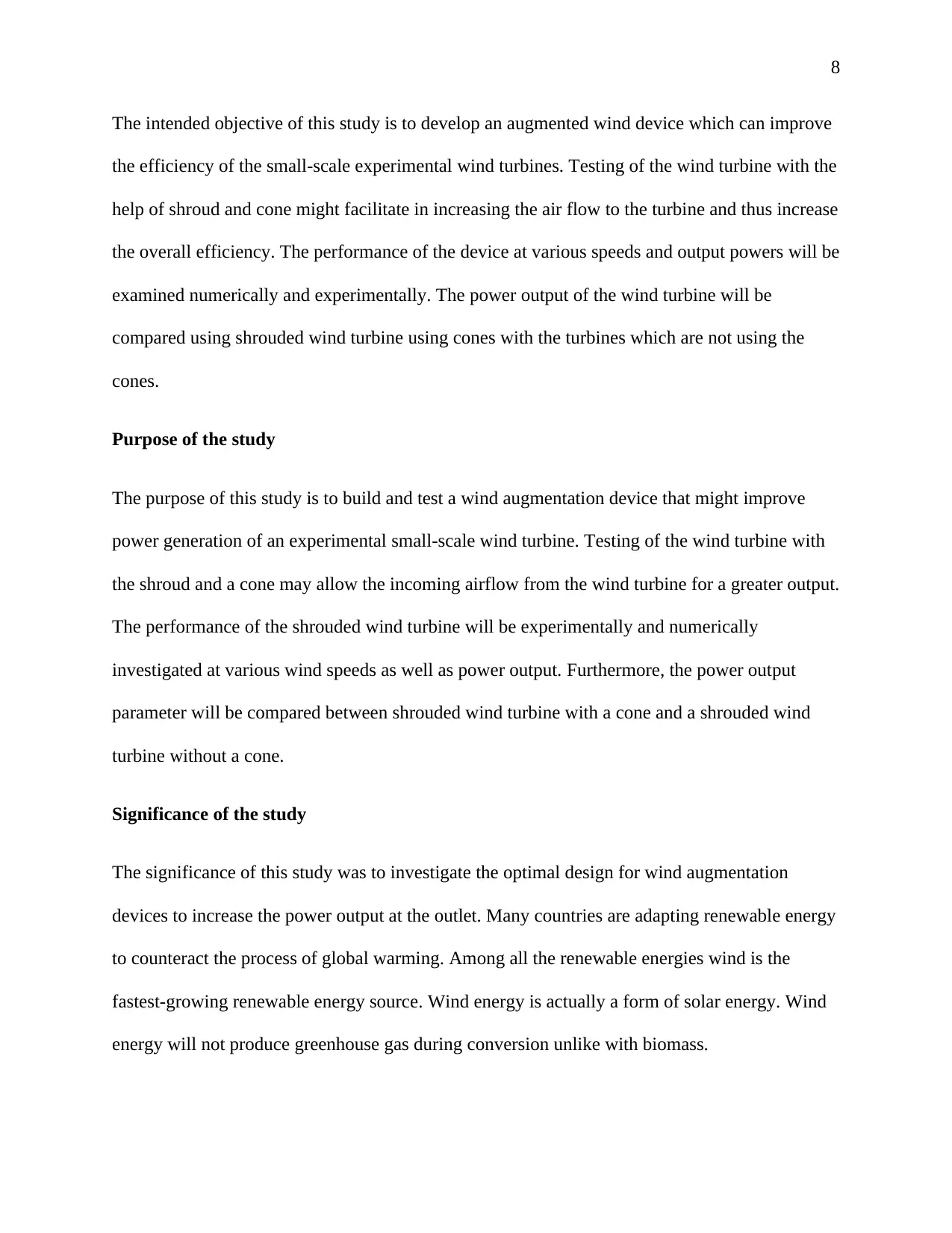
8
The intended objective of this study is to develop an augmented wind device which can improve
the efficiency of the small-scale experimental wind turbines. Testing of the wind turbine with the
help of shroud and cone might facilitate in increasing the air flow to the turbine and thus increase
the overall efficiency. The performance of the device at various speeds and output powers will be
examined numerically and experimentally. The power output of the wind turbine will be
compared using shrouded wind turbine using cones with the turbines which are not using the
cones.
Purpose of the study
The purpose of this study is to build and test a wind augmentation device that might improve
power generation of an experimental small-scale wind turbine. Testing of the wind turbine with
the shroud and a cone may allow the incoming airflow from the wind turbine for a greater output.
The performance of the shrouded wind turbine will be experimentally and numerically
investigated at various wind speeds as well as power output. Furthermore, the power output
parameter will be compared between shrouded wind turbine with a cone and a shrouded wind
turbine without a cone.
Significance of the study
The significance of this study was to investigate the optimal design for wind augmentation
devices to increase the power output at the outlet. Many countries are adapting renewable energy
to counteract the process of global warming. Among all the renewable energies wind is the
fastest-growing renewable energy source. Wind energy is actually a form of solar energy. Wind
energy will not produce greenhouse gas during conversion unlike with biomass.
The intended objective of this study is to develop an augmented wind device which can improve
the efficiency of the small-scale experimental wind turbines. Testing of the wind turbine with the
help of shroud and cone might facilitate in increasing the air flow to the turbine and thus increase
the overall efficiency. The performance of the device at various speeds and output powers will be
examined numerically and experimentally. The power output of the wind turbine will be
compared using shrouded wind turbine using cones with the turbines which are not using the
cones.
Purpose of the study
The purpose of this study is to build and test a wind augmentation device that might improve
power generation of an experimental small-scale wind turbine. Testing of the wind turbine with
the shroud and a cone may allow the incoming airflow from the wind turbine for a greater output.
The performance of the shrouded wind turbine will be experimentally and numerically
investigated at various wind speeds as well as power output. Furthermore, the power output
parameter will be compared between shrouded wind turbine with a cone and a shrouded wind
turbine without a cone.
Significance of the study
The significance of this study was to investigate the optimal design for wind augmentation
devices to increase the power output at the outlet. Many countries are adapting renewable energy
to counteract the process of global warming. Among all the renewable energies wind is the
fastest-growing renewable energy source. Wind energy is actually a form of solar energy. Wind
energy will not produce greenhouse gas during conversion unlike with biomass.
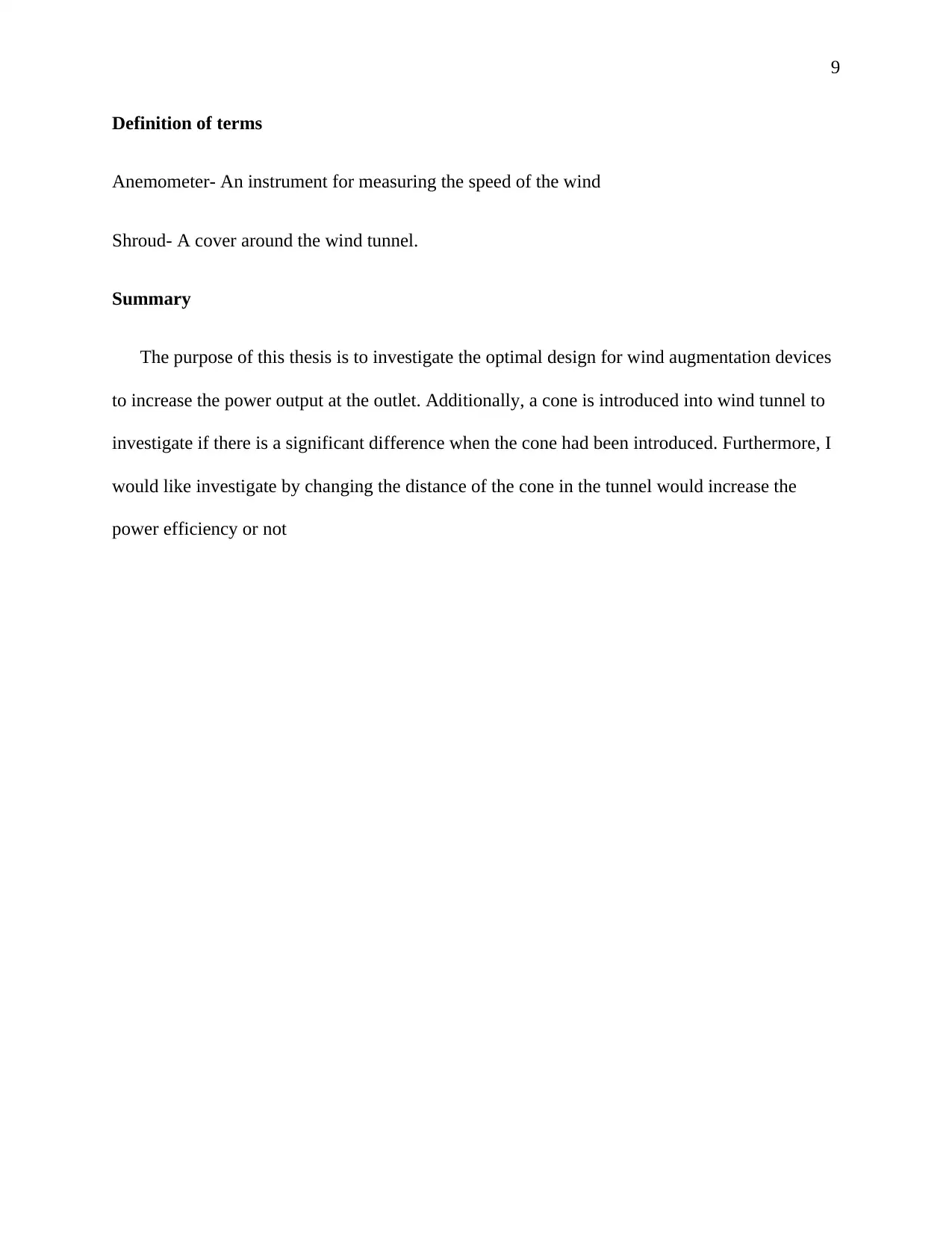
9
Definition of terms
Anemometer- An instrument for measuring the speed of the wind
Shroud- A cover around the wind tunnel.
Summary
The purpose of this thesis is to investigate the optimal design for wind augmentation devices
to increase the power output at the outlet. Additionally, a cone is introduced into wind tunnel to
investigate if there is a significant difference when the cone had been introduced. Furthermore, I
would like investigate by changing the distance of the cone in the tunnel would increase the
power efficiency or not
Definition of terms
Anemometer- An instrument for measuring the speed of the wind
Shroud- A cover around the wind tunnel.
Summary
The purpose of this thesis is to investigate the optimal design for wind augmentation devices
to increase the power output at the outlet. Additionally, a cone is introduced into wind tunnel to
investigate if there is a significant difference when the cone had been introduced. Furthermore, I
would like investigate by changing the distance of the cone in the tunnel would increase the
power efficiency or not
⊘ This is a preview!⊘
Do you want full access?
Subscribe today to unlock all pages.

Trusted by 1+ million students worldwide
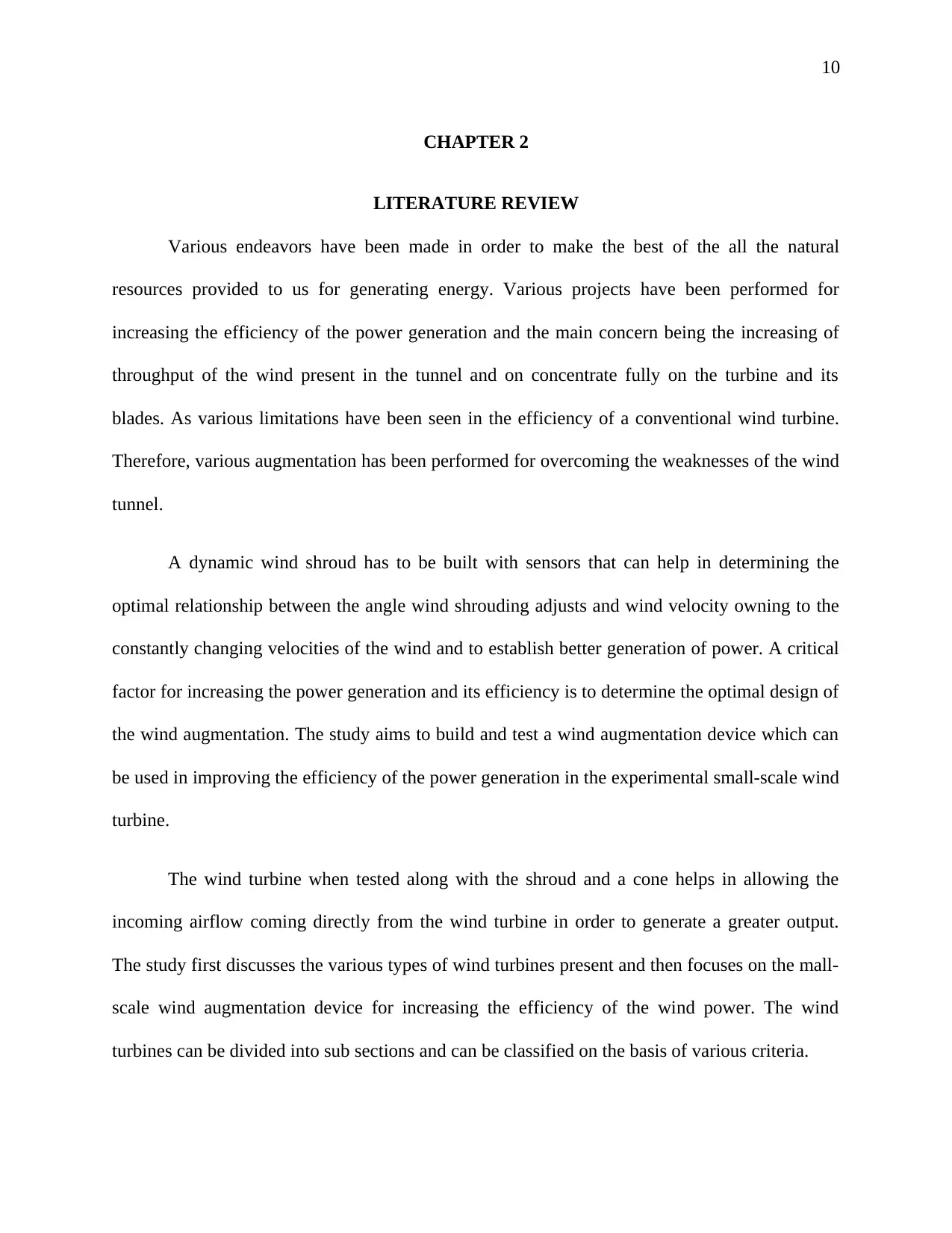
10
CHAPTER 2
LITERATURE REVIEW
Various endeavors have been made in order to make the best of the all the natural
resources provided to us for generating energy. Various projects have been performed for
increasing the efficiency of the power generation and the main concern being the increasing of
throughput of the wind present in the tunnel and on concentrate fully on the turbine and its
blades. As various limitations have been seen in the efficiency of a conventional wind turbine.
Therefore, various augmentation has been performed for overcoming the weaknesses of the wind
tunnel.
A dynamic wind shroud has to be built with sensors that can help in determining the
optimal relationship between the angle wind shrouding adjusts and wind velocity owning to the
constantly changing velocities of the wind and to establish better generation of power. A critical
factor for increasing the power generation and its efficiency is to determine the optimal design of
the wind augmentation. The study aims to build and test a wind augmentation device which can
be used in improving the efficiency of the power generation in the experimental small-scale wind
turbine.
The wind turbine when tested along with the shroud and a cone helps in allowing the
incoming airflow coming directly from the wind turbine in order to generate a greater output.
The study first discusses the various types of wind turbines present and then focuses on the mall-
scale wind augmentation device for increasing the efficiency of the wind power. The wind
turbines can be divided into sub sections and can be classified on the basis of various criteria.
CHAPTER 2
LITERATURE REVIEW
Various endeavors have been made in order to make the best of the all the natural
resources provided to us for generating energy. Various projects have been performed for
increasing the efficiency of the power generation and the main concern being the increasing of
throughput of the wind present in the tunnel and on concentrate fully on the turbine and its
blades. As various limitations have been seen in the efficiency of a conventional wind turbine.
Therefore, various augmentation has been performed for overcoming the weaknesses of the wind
tunnel.
A dynamic wind shroud has to be built with sensors that can help in determining the
optimal relationship between the angle wind shrouding adjusts and wind velocity owning to the
constantly changing velocities of the wind and to establish better generation of power. A critical
factor for increasing the power generation and its efficiency is to determine the optimal design of
the wind augmentation. The study aims to build and test a wind augmentation device which can
be used in improving the efficiency of the power generation in the experimental small-scale wind
turbine.
The wind turbine when tested along with the shroud and a cone helps in allowing the
incoming airflow coming directly from the wind turbine in order to generate a greater output.
The study first discusses the various types of wind turbines present and then focuses on the mall-
scale wind augmentation device for increasing the efficiency of the wind power. The wind
turbines can be divided into sub sections and can be classified on the basis of various criteria.
Paraphrase This Document
Need a fresh take? Get an instant paraphrase of this document with our AI Paraphraser
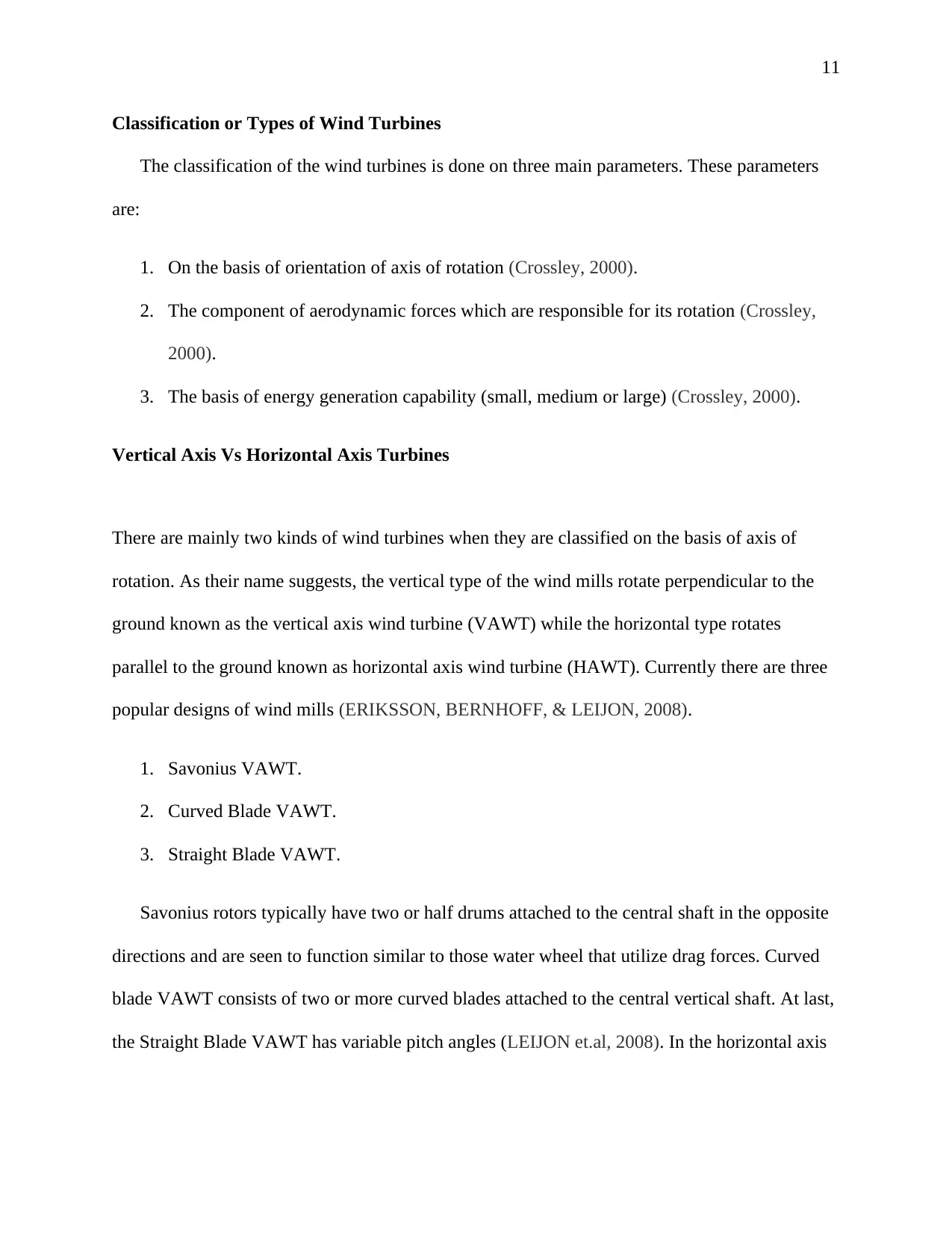
11
Classification or Types of Wind Turbines
The classification of the wind turbines is done on three main parameters. These parameters
are:
1. On the basis of orientation of axis of rotation (Crossley, 2000).
2. The component of aerodynamic forces which are responsible for its rotation (Crossley,
2000).
3. The basis of energy generation capability (small, medium or large) (Crossley, 2000).
Vertical Axis Vs Horizontal Axis Turbines
There are mainly two kinds of wind turbines when they are classified on the basis of axis of
rotation. As their name suggests, the vertical type of the wind mills rotate perpendicular to the
ground known as the vertical axis wind turbine (VAWT) while the horizontal type rotates
parallel to the ground known as horizontal axis wind turbine (HAWT). Currently there are three
popular designs of wind mills (ERIKSSON, BERNHOFF, & LEIJON, 2008).
1. Savonius VAWT.
2. Curved Blade VAWT.
3. Straight Blade VAWT.
Savonius rotors typically have two or half drums attached to the central shaft in the opposite
directions and are seen to function similar to those water wheel that utilize drag forces. Curved
blade VAWT consists of two or more curved blades attached to the central vertical shaft. At last,
the Straight Blade VAWT has variable pitch angles (LEIJON et.al, 2008). In the horizontal axis
Classification or Types of Wind Turbines
The classification of the wind turbines is done on three main parameters. These parameters
are:
1. On the basis of orientation of axis of rotation (Crossley, 2000).
2. The component of aerodynamic forces which are responsible for its rotation (Crossley,
2000).
3. The basis of energy generation capability (small, medium or large) (Crossley, 2000).
Vertical Axis Vs Horizontal Axis Turbines
There are mainly two kinds of wind turbines when they are classified on the basis of axis of
rotation. As their name suggests, the vertical type of the wind mills rotate perpendicular to the
ground known as the vertical axis wind turbine (VAWT) while the horizontal type rotates
parallel to the ground known as horizontal axis wind turbine (HAWT). Currently there are three
popular designs of wind mills (ERIKSSON, BERNHOFF, & LEIJON, 2008).
1. Savonius VAWT.
2. Curved Blade VAWT.
3. Straight Blade VAWT.
Savonius rotors typically have two or half drums attached to the central shaft in the opposite
directions and are seen to function similar to those water wheel that utilize drag forces. Curved
blade VAWT consists of two or more curved blades attached to the central vertical shaft. At last,
the Straight Blade VAWT has variable pitch angles (LEIJON et.al, 2008). In the horizontal axis
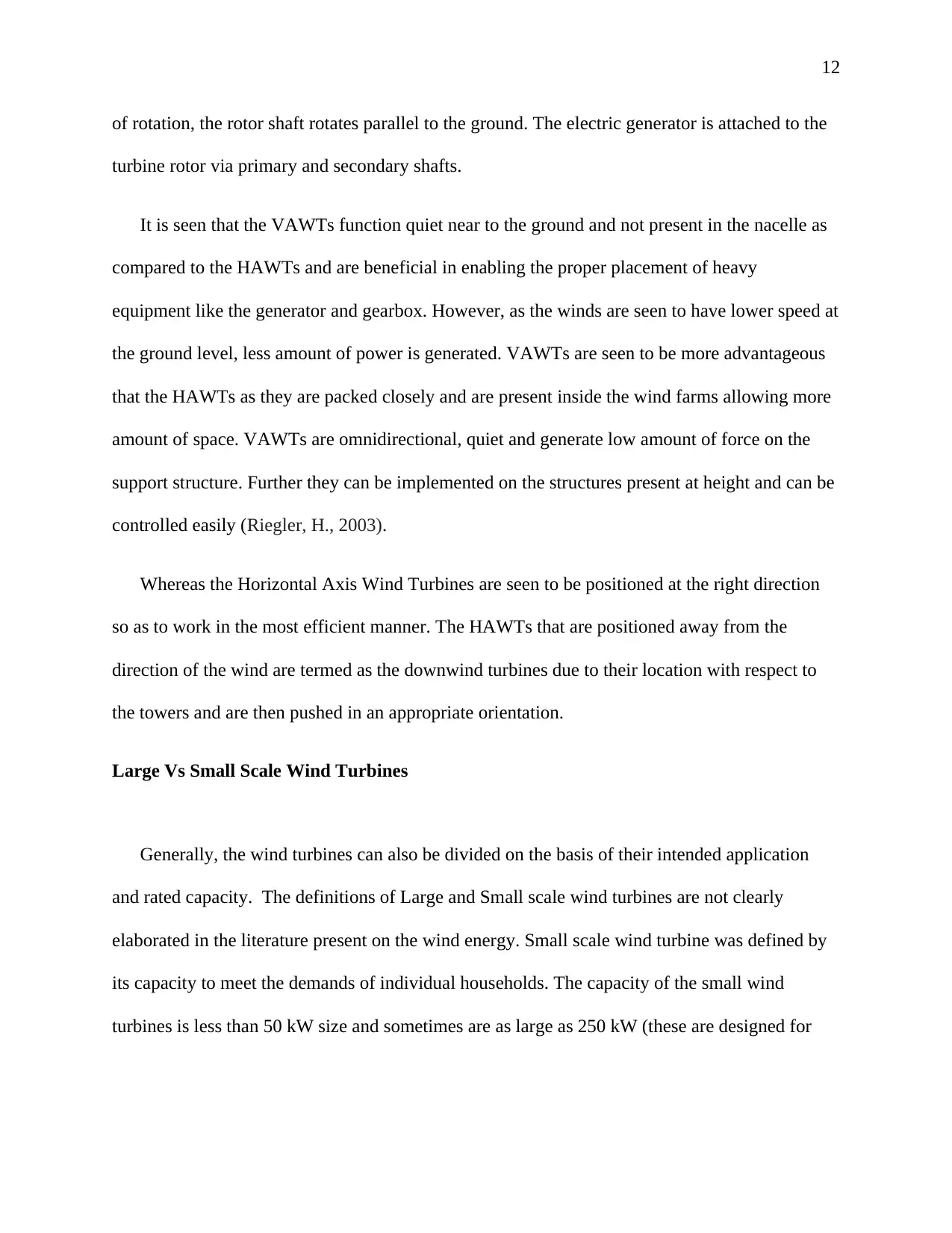
12
of rotation, the rotor shaft rotates parallel to the ground. The electric generator is attached to the
turbine rotor via primary and secondary shafts.
It is seen that the VAWTs function quiet near to the ground and not present in the nacelle as
compared to the HAWTs and are beneficial in enabling the proper placement of heavy
equipment like the generator and gearbox. However, as the winds are seen to have lower speed at
the ground level, less amount of power is generated. VAWTs are seen to be more advantageous
that the HAWTs as they are packed closely and are present inside the wind farms allowing more
amount of space. VAWTs are omnidirectional, quiet and generate low amount of force on the
support structure. Further they can be implemented on the structures present at height and can be
controlled easily (Riegler, H., 2003).
Whereas the Horizontal Axis Wind Turbines are seen to be positioned at the right direction
so as to work in the most efficient manner. The HAWTs that are positioned away from the
direction of the wind are termed as the downwind turbines due to their location with respect to
the towers and are then pushed in an appropriate orientation.
Large Vs Small Scale Wind Turbines
Generally, the wind turbines can also be divided on the basis of their intended application
and rated capacity. The definitions of Large and Small scale wind turbines are not clearly
elaborated in the literature present on the wind energy. Small scale wind turbine was defined by
its capacity to meet the demands of individual households. The capacity of the small wind
turbines is less than 50 kW size and sometimes are as large as 250 kW (these are designed for
of rotation, the rotor shaft rotates parallel to the ground. The electric generator is attached to the
turbine rotor via primary and secondary shafts.
It is seen that the VAWTs function quiet near to the ground and not present in the nacelle as
compared to the HAWTs and are beneficial in enabling the proper placement of heavy
equipment like the generator and gearbox. However, as the winds are seen to have lower speed at
the ground level, less amount of power is generated. VAWTs are seen to be more advantageous
that the HAWTs as they are packed closely and are present inside the wind farms allowing more
amount of space. VAWTs are omnidirectional, quiet and generate low amount of force on the
support structure. Further they can be implemented on the structures present at height and can be
controlled easily (Riegler, H., 2003).
Whereas the Horizontal Axis Wind Turbines are seen to be positioned at the right direction
so as to work in the most efficient manner. The HAWTs that are positioned away from the
direction of the wind are termed as the downwind turbines due to their location with respect to
the towers and are then pushed in an appropriate orientation.
Large Vs Small Scale Wind Turbines
Generally, the wind turbines can also be divided on the basis of their intended application
and rated capacity. The definitions of Large and Small scale wind turbines are not clearly
elaborated in the literature present on the wind energy. Small scale wind turbine was defined by
its capacity to meet the demands of individual households. The capacity of the small wind
turbines is less than 50 kW size and sometimes are as large as 250 kW (these are designed for
⊘ This is a preview!⊘
Do you want full access?
Subscribe today to unlock all pages.

Trusted by 1+ million students worldwide
1 out of 22
Related Documents
Your All-in-One AI-Powered Toolkit for Academic Success.
+13062052269
info@desklib.com
Available 24*7 on WhatsApp / Email
![[object Object]](/_next/static/media/star-bottom.7253800d.svg)
Unlock your academic potential
Copyright © 2020–2025 A2Z Services. All Rights Reserved. Developed and managed by ZUCOL.





